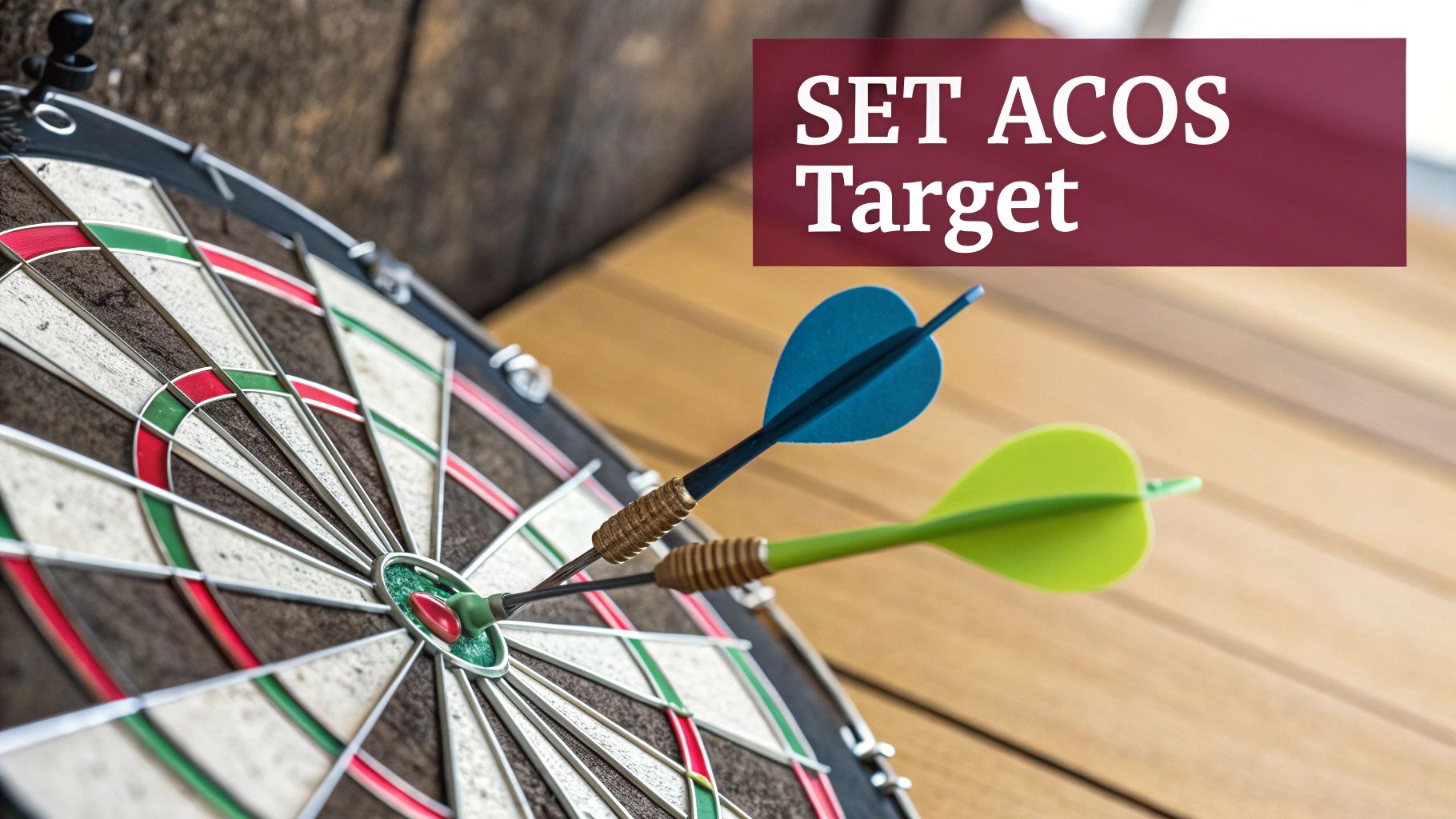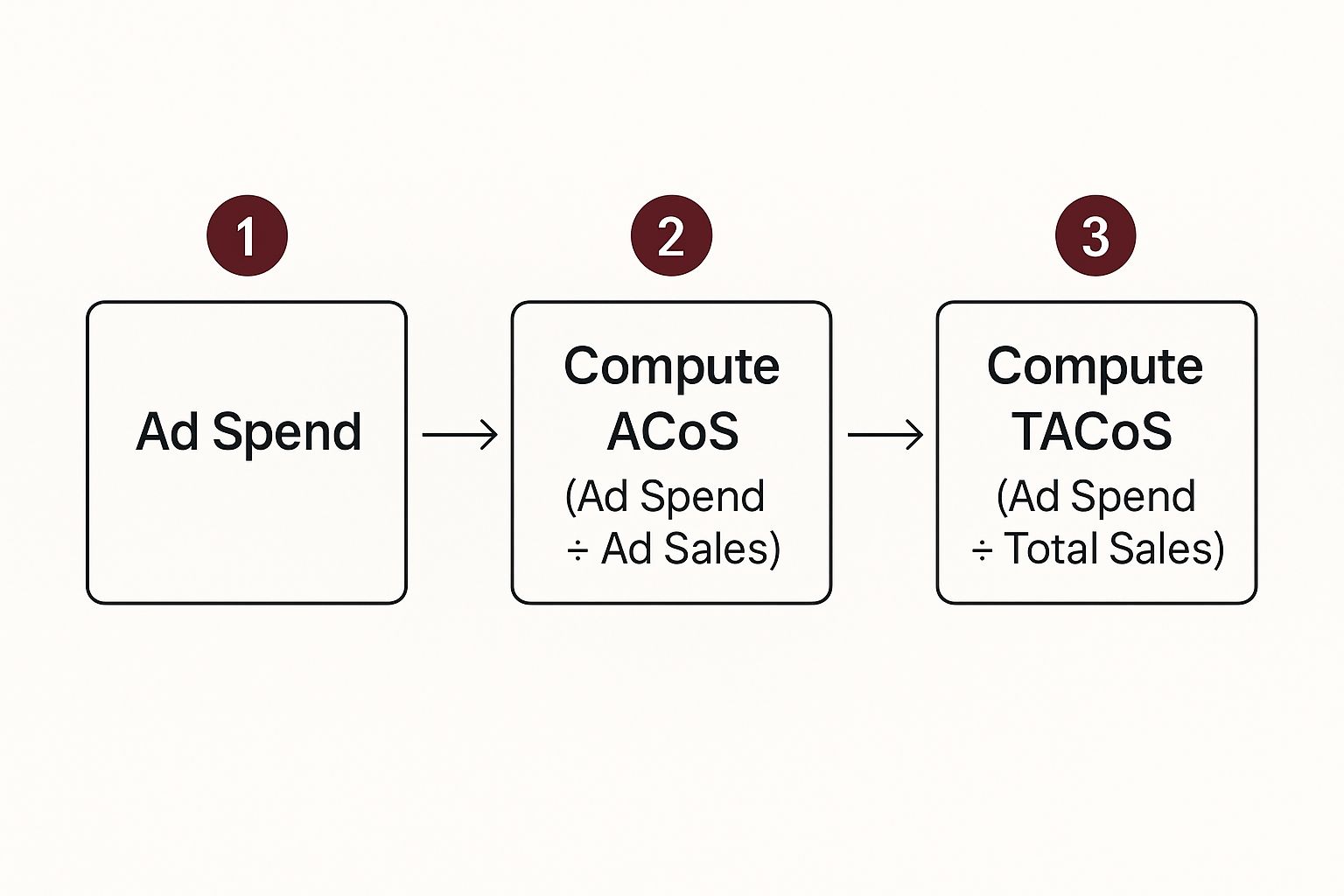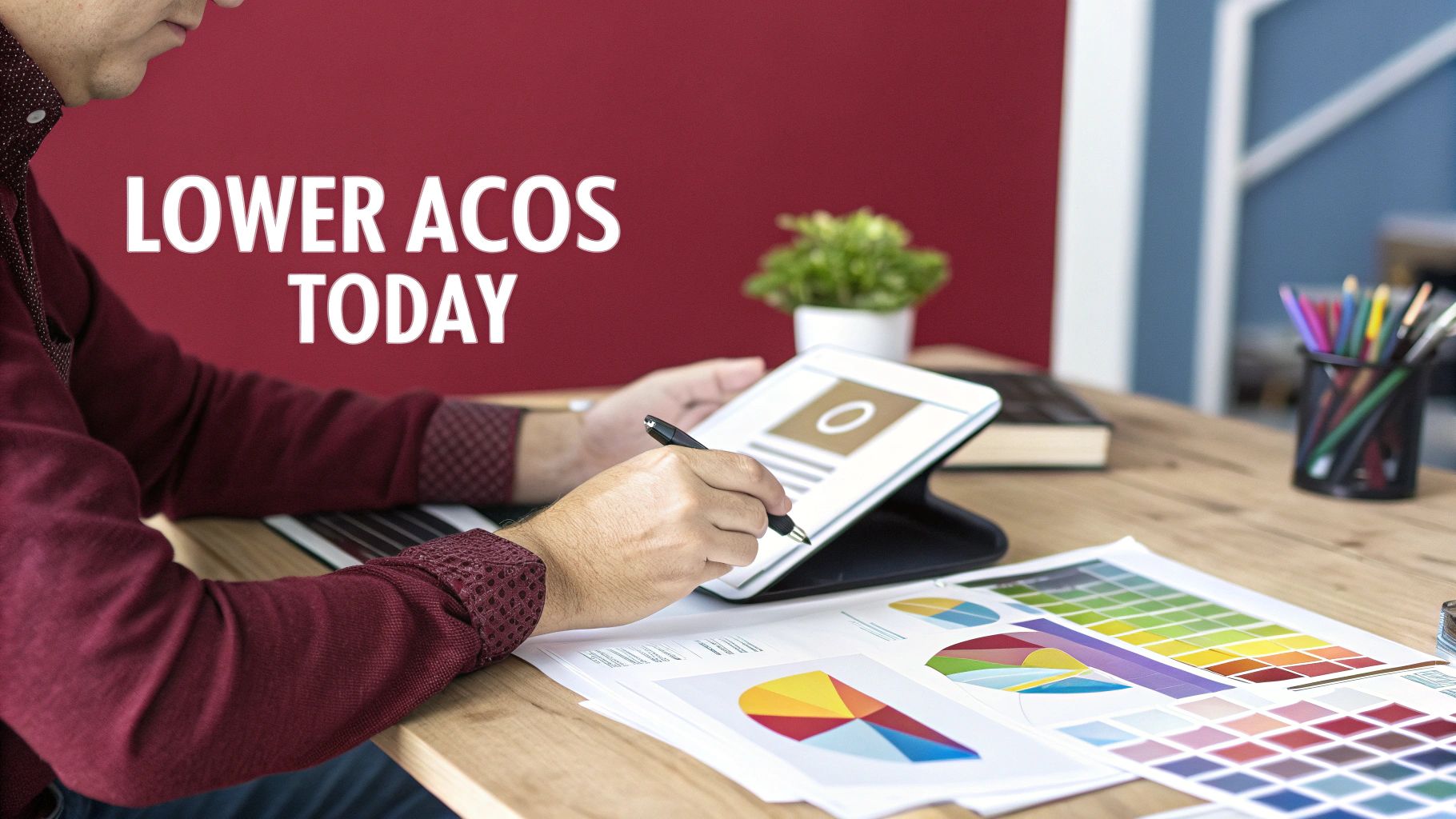Amazon ACoS stands for Advertising Cost of Sales. It’s the percentage of ad spend compared to the sales your ads generate. In simple terms, it shows how much you spend to make each dollar in sales.
A lower ACoS means more profit, while a higher ACoS means you’re spending more than you should on ads.

The calculation is simple:
ACoS = Total Ad Spend ÷ Total Ad Sales
So, if you spend $50 on ads and those ads generate $200 in sales, your ACoS is 25% ($50 ÷ $200). In plain English, you spent 25 cents for every dollar you made. Easy enough, right?
Why ACoS Is More Than Just a Number
Understanding your ACoS is fundamental because it directly shapes your profitability. It’s the number that helps you decide how much to bid on keywords and where to put your ad budget.
If your ACoS is too high, you might be losing money on every single sale. If it’s too low, you’re likely leaving money on the table by not being aggressive enough and missing out on sales volume.
While you’ll hear that the platform-wide average ACoS hovers around 25–30%, that number is mostly noise. What truly matters is your break-even point.
Here’s a quick example for 2025:
- Your product sells for $25.
- After all costs (manufacturing, shipping, Amazon fees), your profit is $9.
- Your break-even ACoS is 36% ($9 profit ÷ $25 sale price).
Any ACoS below 36% means your campaign is profitable. Anything above it means you’re in the red. It’s that simple.
To help you get a quick read on your own campaigns, here’s a table that breaks down what different ACoS levels usually mean for a business.
ACoS Profitability at a Glance
| ACoS Level | What It Means for Your Business | Typical Scenario |
|---|---|---|
| 0-15% | Highly Profitable: You’re spending very little to acquire sales. | Great for established products with strong organic rank or branded search campaigns where customers are already looking for you. |
| 16-30% | Healthy & Sustainable: A solid balance between ad spend and sales. | A common and desirable range for mature products in competitive, but not overly saturated, niches. |
| 31-40% | Growth-Focused or Break-Even: You’re reinvesting profits into growth. | Often seen during new product launches, pushing for market share, or when aiming to just cover costs on a specific campaign. |
| 41%+ | Losing Money (Investment Phase): Your ad spend exceeds your profit margin per sale. | This is a strategic loss. It’s acceptable for launching a brand-new product or liquidating old inventory, but it isn’t sustainable long-term. |
ACoS is a key performance indicator that fits into your bigger marketing picture. If you’re new to this world, concepts like ACoS become much clearer with a solid foundation, and this beginner’s guide to digital marketing is a great place to start building that knowledge.
Setting a Realistic ACoS Target

First things first: forget the myth of a single “good” ACoS. The right target is completely situational. It depends on where your product is in its lifecycle and what you’re trying to accomplish. Chasing an arbitrarily low number can stall your growth just as much as letting your ad spend run wild.
Are you launching a brand new product? Your goal isn’t immediate profit. It’s about buying data, getting those initial sales, and getting your product on Amazon’s radar. In this launch phase, a higher ACoS is a necessary investment to build momentum.
But if you’re managing a bestseller with a solid sales history, the game changes. Your focus shifts to maximizing profit, which means aiming for a lower ACoS. For established products, a target of 15–20% often creates healthy margins. During a launch, however, accepting an ACoS of 40–50% is a common and effective strategy.
Finding Your Break-Even ACoS
Before you set any target, you need to know your absolute floor. Your break-even ACoS is the highest your ACoS can go before you start losing money on each ad-driven sale. This number is your guide for every PPC decision you make.
Calculating it is straightforward. You just need three key figures:
- Selling Price: What the customer pays.
- Cost of Goods Sold (COGS): How much it costs you to source or make one unit.
- Amazon Fees: This includes referral fees, FBA fees, and other variable costs. We dive deep into these in our complete guide to Amazon fees for sellers.
Here’s the formula:
Break-Even ACoS = (Selling Price – COGS – Amazon Fees) / Selling Price
Let’s walk through an example. Imagine your product sells for $40. Your COGS is $10, and all Amazon fees add up to $12. That leaves you with a pre-ad profit of $18 per unit ($40 – $10 – $12).
Using the formula, your break-even ACoS would be 45% ($18 ÷ $40). This means any ad campaign running below a 45% ACoS is profitable.
Looking Beyond ACoS to TACOS
It’s easy to get tunnel vision with ACoS. While it’s a great metric for checking ad efficiency, relying on it alone means you’re missing half the story. ACoS tells you nothing about how your ads are lifting your organic sales, which is the long-term goal.
This is where a more holistic metric comes into play: Total Advertising Cost of Sale (TACOS). Think of TACOS as the true health report for your entire Amazon business, showing how your ad spend fuels overall growth, not just direct sales from clicks.
How to Calculate and Use TACOS
The formula is refreshingly simple:
TACOS = Total Ad Spend ÷ Total Sales (Ad Sales + Organic Sales)
At first glance, a high ACoS might make you nervous. But if your TACOS is low and trending downward, you’re actually in a great spot. It’s a clear sign that your ad campaigns are boosting your product’s organic rank and generating more “free” sales over time. Your ads are creating a halo effect, and that’s exactly what you want.
This infographic breaks down how ACoS and TACOS work together.

You have to factor in both ad-driven and organic revenue to really understand your advertising’s total impact.
Here’s a good way to think about it: ACoS helps with short-term campaign tweaks, while TACOS guides your long-term business strategy.
For instance, you might run a launch campaign with a high ACoS of 70%. If you see your TACOS drop from 40% to 25% over a few weeks, that initial ad spend was a smart investment. It built the organic momentum you needed. This metric is just as vital as Return on Ad Spend (ROAS), and it’s important to know when to use each one. You can dive deeper into this in our guide on ACoS vs. ROAS.
Ultimately, a falling TACOS is the proof you need. It shows your advertising isn’t just buying sales for today; it’s building a sustainable business for tomorrow.
Practical Steps to Lower Your Amazon ACoS
Knowing your numbers is one thing, but improving them is another. If your ACoS is running hotter than your target, it’s time to take action. Forget vague advice; here are specific strategies you can implement this week to get your ad spend under control.

Your campaign dashboard is where the analysis begins, helping you spot which campaigns are bleeding cash.
1. Hunt Down and Eliminate Wasted Spend
The fastest way to lower your ACoS is to stop spending money on clicks that don’t convert. Your first stop should be the Search Term Report, especially for your automatic and broad match campaigns. Your mission is to find search terms that are irrelevant to what you sell.
For example, if you sell a “silicone baking mat,” you don’t want to pay for clicks from someone searching for a “silicone play mat for toddlers.” That’s a classic budget drain.
- Action Step: Pull your Search Term Report.
- Filter for terms with zero sales that have at least 8-10 clicks.
- Add these irrelevant terms as negative exact match keywords. This immediately stops your ads from showing up for those useless queries.
2. Graduate Your Winning Keywords
Auto campaigns are brilliant for discovery. They find the paths customers are taking to find products like yours. But once a keyword proves it can consistently bring in profitable sales, it’s time to move it to a manual campaign.
By moving a proven search term to a manual campaign, you get precise control over its bid. You can push it aggressively if it’s a strong performer or manage it more conservatively to hit a specific ACoS. This level of precision isn’t possible in an auto campaign.
3. Optimize Your Listing to Boost Conversion
Sometimes, the problem isn’t your ads. It’s your product page. A low conversion rate is a guaranteed recipe for high ACoS because you’re paying for clicks that don’t turn into sales. Improving your listing is one of the most powerful ways to lower your ACoS without ever touching your bids.
- Main Image: Does your main photo stand out in a crowded search results page? Does it clearly show the product and its single biggest benefit?
- Title: Is your most important keyword right at the beginning, within the first 80 characters? Is the title easy for a person to read?
- A+ Content: Are you using high-quality images and well-designed modules to answer customer questions before they even ask them?
Even small tweaks here can lift your conversion rate, which directly pushes your ACoS down. Nailing your listing optimization is a core part of effective Amazon ads management, because it makes every dollar you spend work harder.
Troubleshooting a High ACoS
When your Amazon ACoS starts creeping up, it’s a signal that something needs your attention. It could be an issue with your keywords, your listing, or your campaign strategy.
Figuring out the why is the first step to getting things back on track.
Often, a high ACoS comes down to a few common issues. You might be bidding on keywords that are too broad, or maybe your conversion rate is low because your product listing isn’t convincing enough.
Diagnose and Fix Common ACoS Issues
Let’s walk through the most common problems and what you can do about them.
- Problem The Keyword is Too Broad: You sell “organic dog treats,” but your ads keep showing up for a generic term like “dog supplies.” You’re attracting clicks from shoppers looking for leashes, bowls, or toys, which tanks your conversion rate.
- The Fix: Go to your Search Term Report. Find those expensive, irrelevant terms and add them as negative exact match keywords. This is the quickest way to stop the bleeding.
- Problem Your Listing Isn’t Converting: You’re getting a ton of clicks, but the sales aren’t following. This signals a weak listing, maybe due to a bad main image, a confusing title, or not enough positive reviews to build trust.
- The Fix: Start by A/B testing your main image to see what shoppers respond to. Rewrite your bullet points to focus on customer benefits, not just a list of features. A well-optimized listing is one of the best ways to lower ACoS naturally.
Keep in mind that seasonal trends can also affect your numbers. For instance, ACoS often peaks in October as sellers start spending aggressively for the holiday rush. It then usually drops in December when a flood of organic holiday traffic makes every ad dollar go further.
Digging Deeper with Data
When you’re trying to fix a stubborn ACoS, relying on solid data is non-negotiable. Using ecommerce analytics software can be a huge help here, letting you spot performance patterns over time that you’d likely miss otherwise.
If your ACoS still won’t budge after trying these fixes, it might be time to call in the pros. Partnering with experienced Amazon PPC agencies can give you the expert eye needed to audit and restructure your campaigns for long-term profitability.
Common Questions About Amazon ACoS
Even seasoned sellers get tripped up by ACoS sometimes. Let’s walk through some of the most common questions we hear.
What Is a Good Starting ACoS for a New Campaign?
For a new product launch, you need to be comfortable with a high ACoS, often way above your break-even point. We’re talking in the 40-70% range, maybe even higher.
Don’t panic. The goal here isn’t profit. It’s about gathering keyword data and kickstarting sales to build ranking momentum. Plan to run at a strategic loss for the first few weeks; think of it as an investment in getting your product seen.
Should I Aim for the Lowest ACoS Possible?
Not necessarily. An extremely low ACoS might feel like a win, but it often means you’re playing it too safe with your bids. You’re likely leaving sales on the table by not being aggressive enough to win valuable ad placements.
The sweet spot is an ACoS that balances healthy profits with steady sales growth. Your real goal should be hitting your calculated target ACoS, not just chasing the lowest number.
As a general rule, an ACoS below 25% is great for most established products. Anything climbing above 35% is usually considered high and might not be sustainable long-term, unless it’s part of a specific launch strategy. For a deeper dive, check out this guide to Amazon ACoS.
How Long Should I Wait Before Optimizing a Campaign?
Patience is important. Give a new campaign at least one to two weeks to collect enough data before you start making big changes.
Amazon’s attribution window can take a few days to fully report sales. If you react too quickly and pause a keyword after just a couple of days, you might be cutting off a future bestseller before it had a chance to prove itself.
Can My Business Be Profitable with a High ACoS?
Absolutely, but with one big condition: your TACOS (Total Advertising Cost of Sale) needs to be healthy and ideally trending downward over time.
TACOS looks at your ad spend relative to your total sales (both paid and organic). If your high ACoS campaigns are giving your organic sales a major lift, your business as a whole can be very profitable. This is a common and powerful strategy for brands focused on grabbing market share and building a strong organic rank.





